 |
 |
 |
HOME > FOCUS > Space-Time Continuums by Kenichi Sawaki at the Meguro Museum of Art, Tokyo
|
 |
 |
Focus features two in-depth reviews each month of fine art, architecture and design exhibitions and events at art museums, galleries and alternative spaces around Japan. The contributors are non-Japanese art critics living in Japan. |
|
|
 |
 |
 |
Space-Time Continuums by Kenichi Sawaki at the Meguro Museum of Art, Tokyo
Susan Rogers Chikuba |
 |
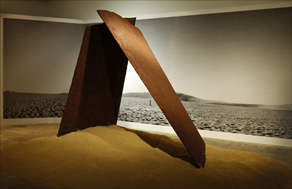 |
|
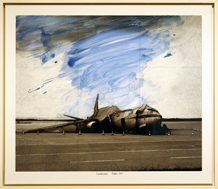 |
|
|
|
| With rusted designs of iron and bronze, and multimedia works featuring an ever-present blue sky, sculptor Kenichi Sawaki probes moods of nostalgia, loss, and hope in his Memory of Future show. Left: Wing Gate (2009); right: Landscape: Naha 2007 (2009). Photos by Jeff Amas |
Through barren landscapes, forgotten landmarks of manmade origin, and short films sequenced like fragmented images from a dream, sculptor Kenichi Sawaki explores themes of life and death, boom and bust, and ultimately, our place in the inevitable flux of things in Memory of Future, a solo exhibition ending June 9 at the Meguro Museum of Art, Tokyo.
Born in 1949, Sawaki studied metal casting and received his MA at Tokyo University of the Arts. He's now a professor at Oita University, where his course in contemporary sculpture treats its subject as the "shaping of space and time," addressing today's freedom of method and material through visual arts as diverse as lost-wax casting, earthworks, multimedia installations, and film. Sawaki applies that multivalent approach to this exhibition, which, with nearly 130 items on display, is the largest he has launched to date.
Before coming to Tokyo in April, Memory of Future opened last fall at the Oita Art Museum in Sawaki's hometown, where it drew more than 6,700 visitors in a six-week run. While his recent projects involving memory boxes, installations, film, and brushstrokes of paint on black-and-white photographs feature prominently, it is the artist's signature metal works that are by far the show's highlight.
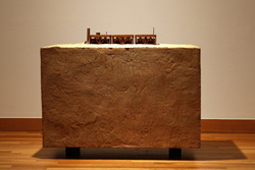 |
|
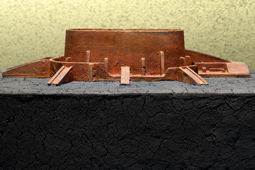 |
|
|
|
| Some of Sawaki's rusted-out ruins are set on huge pedestals of hard-caked sand, literally and figuratively grounding the object in its relationship to the earth and to us, the viewers. His Seal series takes repositories for spent nuclear fuel as its subject. Left: Landscape: Yellow Soil (1998); right: Landscape: Seal 2013-1 (2013). Photos by Jeff Amas |
Calling to mind both the films of Hayao Miyazaki and the great sci-fi flicks of the past half century, Sawaki's works in iron and bronze portray the rusting hulks of abandoned industrial infrastructure -- coal-mining facilities, smokestack factories, oil rigs and towers, even nuclear reactors and plutonium storage tanks. (Interestingly, Sawaki completed his initial sculptures of decommissioned nuclear plants and their waste before the March 2011 disasters, the first as early as 1989 -- a fact that gives added poignancy to the show's titular theme.) There's modern-day weaponry, too -- warplanes, torpedoes, nuclear submarines. Our bird's-eye-view of these carefully detailed miniature landscapes and artifacts yields an in-the-moment immediacy that's simultaneously countered by a sense of time gone past, evidenced by the rust and the absence of any human activity.
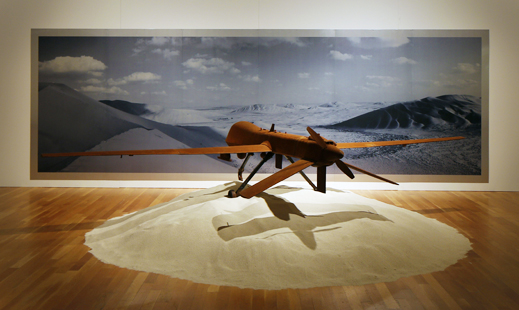 |
|
| Sawaki traveled to the Gobi Desert to capture the images that are backdrop to the installations Landmark 2012 (2012), shown here, and Wing Gate (2009), at top. Photo by Jeff Amas |
This time-warp trickery is delivered most powerfully in the large installation Landmark 2012. What seems at first glance to be nothing more than the rusted hull of an old aircraft turns out upon closer inspection to be a state-of-the-art Predator drone, seen here as if from centuries hence. Viewing such desolate ruins of present-day technology brings to mind the plight of the astronauts in the Planet of the Apes films, crash-landing from a time in the future to find themselves in the Forbidden Zone.
|
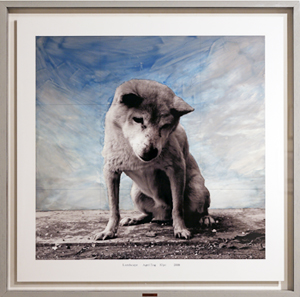 |
|
|
|
Landscape: Aged Dog Kiyo 2008 (2009).
Photo by Jeff Amas
|
The collapsing of time and space is seen also in Sawaki's Photo Drawing series of black-and-white stills onto which he has painted bold swathes of blue sky. Amid the images of copper-refining and nuclear plants, a limestone mine, plane wreckage, the abandoned coal-mining facilities of Nagasaki's Hashima (popularly known as "Gunkanjima," or Battleship Island), and Australia's iconic Uluru monolith, there are portraits, too: a young girl, an aged dog looming larger than life, the artist himself as a boy. Past, present, and future collide and unfold, mixing with viewers' own memories to elicit reflections on the grand natural flow between things impermanent and things that last. Two short films on show, Reminiscence and Album, are Sawaki's personal explorations of this theme.
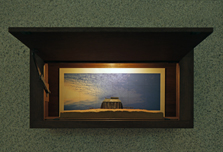 |
|
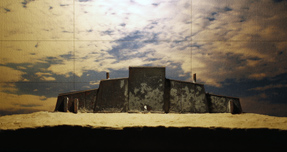 |
|
|
|
| Surface, form, texture, and light play together in Sawaki's Woodwork series. Left: Landscape: Ruins CB-L001 (2009); right: Landscape: Ruins CB-M007 (2012). Photos by Jeff Amas |
In the Woodwork series, a single palm-sized stone or sculpture of cast iron sits in a wooden cabinet that lights when opened, revealing a vast blue sky. Dozens of these walnut boxes punctuate the space of two darkened galleries, their tiny spotlights like so many acts of a play set before us. For Sawaki they reference the kamidana household shrine or butsudan altar, linking the past with the present, or the individual to the larger world of ancestral spirits. Their displays are meant to be viewed as one would a bonsai tree or suiseki stone -- each a microcosm of nature, yet with an element of human agency that evokes nostalgia and a sense of fragility.
Sawaki's abandoned industrial landscapes and broken-down hulks of machinery point to the inherent limitation of our endeavors: the inseparable relationship between creation and change that eventually turns all our works to rubble. But there is no overt emotionalism or social commentary on his agenda; if anything, he shows the stateliness found amid the march to decay. Like the shape of a mountain or rock, the unique bent of a tree, or the textured beauty of rust and cracked earth, our creations and we ourselves are, in the end, products of random spontaneous forces. Memory of Future suggests that if there is one constant to be found, it's the open sky that forever stretches overhead.
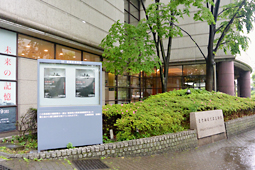 |
|
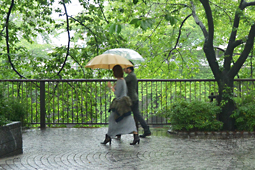 |
|
|
|
One of Tokyo's finest municipal art venues, the Meguro Museum of Art sits in a park-like setting alongside the Meguro River. Benches on the grounds invite a lunch-break visit; even on a rainy day, the riverside tree canopy affords a pleasant stroll all the way to Nakameguro Station, about a mile away.
Photos by Susan Rogers Chikuba
All exhibition images are by permission of the Meguro Museum of Art, Tokyo. |
 |
 |
Susan Rogers Chikuba
Susan Rogers Chikuba, a Tokyo-based writer, editor and translator, has been following popular culture, architecture and design in Japan for 25 years. She covers the country's travel, real estate, hospitality and culinary scenes for domestic and international publications. |
|
 |
|
|
 |
|
 |
|